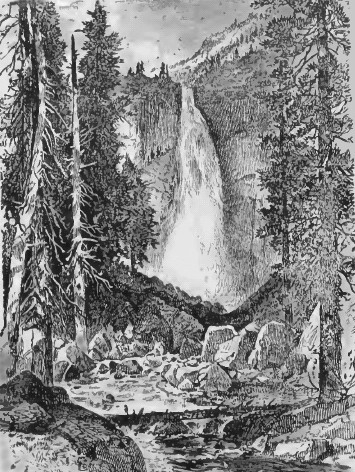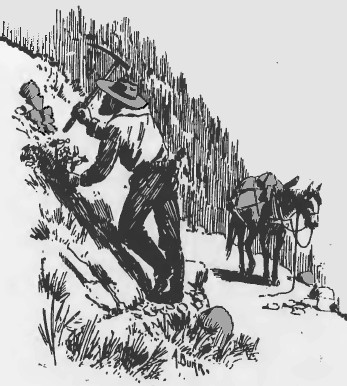When considering the origins of the valuable gold bearing gravels of California, there can be no doubt that the auriferous gravels have been formed at the expense of eroded croppings of the quartz veins; and the veins, or most of them, must therefore have been deposited before the gravels. The resulting gravels, according to Professor Whitney, were accumulated during the whole of the Tertiary period, while Cretaceous gravels appear to be entirely absent. The range was above water during the Cretaceous, and such fresh-water deposits as accumulated on its west slope seem to have been swept away during the succeeding period. The natural inference would seem to be that the formation of the veins occurred between the end of the Jurassic and the beginning of the Tertiary, and that it was intimately connected with the upheaval of the Sierra and the metamorphism of the strata of preceding epochs. Substantially coincident with the area of gold veins is that of the auriferous gravels of California. In the gold bearing regions of all countries secondary deposits of the metal, associated with gravel or sand, have played, in large part, because the gold may be separated from such loose material at a low cost.
In California, however, the gravels have proved particularly important because of the invention and development there of the peculiar system of hydraulic mining, which consists in washing the gravels into sluices provided with quicksilver by the aid of powerful jets of water. The great importance of this system is due to the fact that it is among the least costly methods of handling material, if it is not the very cheapest known. It costs under favorable circumstances but five cents per cubic yard, or, say, three cents per ton, and sometimes even less. It thus renders deposits of gravel valuable which under most conditions would be absolutely worthless. Several conditions, however, are necessary to the successful prosecution of hydraulic mining, among which the most important are a deep gravel bank, abundance of water with a great head, and some available valley at a lower level than the bank, into which the gravel from which the gold has been extracted may be washed. The topographical and climatic conditions in the Sierra are peculiarly favorable for this process, while in Australia, where gravel is abundant, circumstances rarely permit the application of this method of extraction.
The gravel consists of boulders and pebbles of various rocks, with silt, clay, and volcanic ash. The gold occurs as nuggets and fine particles, free or nearly free from rock, but also as fragments of gold quartz, and is accompanied by a variety of other heavy substances, as magnetite, garnet, and zircon; rarely and locally also by cinnabar, platinum and iridosmine, diamonds, native copper , and other substances of high specific gravity. One of the striking features of most deep gravel banks is the so-called "blue lead". This name is applied to the lower portions of banks, which are generally somewhat closely compacted and possess the color of the blue clays occurring all over the world. Although the famous "blue lead" has led to wholly untenable theories as to the character of the gravel deposits, its nature is very readily accounted for. Loose materials near the earth's surface are everywhere impregnated with a small amount of organic matter carried down from the surface by water and filtered from it by the porous strata. This organic matter, in the absence of free oxygen, exercises a slow but inevitable reducing action of ferric oxide and on some ferric compounds, and gives the soil the bluish color characteristic of the presence of iron in the ferrous state. Close to the surface, however, oxygen, either gaseous or in aqueous solution, more than counterbalances the reducing action of the organic matter, and above a certain line the gravel is consequently reddened by ferric oxide. In shallow deposits the gravel is usually reddened to the bottom, but of course this does not necessarily imply that such gravels have a different origin from those of a bluish tint.
To a very large extent the deep gravels are covered by a capping of volcanic material, sometimes as solid black basalt, and sometimes as loose volcanic "ash"; and while some banks are not thus covered, these are rarely at any great distance from volcanic capping. The volcanic material has protected the gravels in many cases from erosion, but there is also a connection in their deposition. The gravels occur in ancient river beds, which formed the natural channels for the flow of lava as well as of water. Volcanic eruptions occurred during the period of the gravel formation, as well as at its close, and sheets of ash or even of solid lava are found in the banks as well as upon them. When the lava cap is thick and solid the gravels can only be mined by drifting, and are not workable by the, hydraulic process. Besides the deep gravels, which date from a period prior to the volcanic eruptions, there are many accumulations of recent origin. The bars of the present river system have yielded great quantities of gold, and there are many shallow placer deposits which are no doubt due to the modern erosion of quartz out croppings, while others are a consequence of the erosion of older gravels. The modern gravels, however, are trifling in quantity as compared with the older deposits. Some of the shallow placers are no doubt mere remnants of deeper Tertiary gravels which have not been wholly carried away by the erosion of the present epoch. The bed-rock of the gravel deposits varies in character, being either limestone, granite, or metamorphic slate; but the last is the rule, and few important deposits occur far from the slate bed-rock, which, as has been explained, is the main, though not the exclusive, habitat of the gold veins. In nearly all cases the gravel rests in local depressions, early recognized by the California miners as the beds of former streams. Many of the gravels, it is true, are high above the present drainage system, and even form the tops of hills; but this is due to the erosion of the present stream-beds, which have been cut down to a great depth since the gravel period.
The bed-rock is usually rough, consisting of nearly vertical slates, and the natural crevices, or "riffles", large and small, thus formed often contain extremely rich gravel. As might naturally be supposed, the greater part of the natural gold is generally found near the bed-rock, for as gold is about seven times as heavy as ordinary rock every disturbance of a gravel bar in a stream tends to shift the gold to a lower level. Sometimes, however, rich gravel is again deposited over a comparatively firm stratum in the gravel, and occasionally gold is quite uniformly disseminated through a whole bank An idea has been current in the mining region that by some process masses of gold in the gravel have increased in size. For this there is absolutely no valid evidence. The rounded masses of gold found could not have been deposited from solution in that form or with such a surface. They have been beaten and worn into shape, much as the accompanying pebbles have been formed, the only difference being due to the fact that gold is malleable. Professor Whitney believes it probable that the higher croppings of the gold veins were richer and contained larger masses of gold than the lower portions of the veins still in place, and if there was any difference at all it was probably of that character. As Professor Newberry (a) points out, however, the gravels represent vastly more vein quartz than has been extracted by deep mining, and the proportion of large masses of gold met with in the veins probably bears as great a ratio to the total weight of quartz extracted, as do the nuggets in the gravels to the quartz from which their metallic contents were derived. The investigations of the state survey have shown that the deep gravels were deposited by rivers which headed in the high Sierra and ran in a westerly direction, emptying into the sea, which, in Tertiary time, occupied the great valley of California. Although all the details of the former river system cannot now be traced out, the courses and relations of the channels developed by hydraulic mining seem to establish this point beyond a question.
There were two great rivers in the Pliocene epoch, one corresponding to the American and the other to the Yuba; but the Bear river of that time probably emptied into the American at a considerable height above the valley. The gravels cannot possibly have accumulated under the present conditions of precipitation. A far greater erosive power than that exhibited by the California streams of to-day must have been exerted at the time in question, as no one can doubt who has ever visited the gold belt. For a long time past the present rivers have merely been deepening their narrow courses, and when freshets occur they merely serve to sweep the canons clear of debris, but cannot alter the course of the stream. The width of the old channels, as well as the character of the deposits, shows that the old rivers were tumultuous streams of great volume, which frequently burst their bounds and formed new beds. The evidence of enormous erosive power during the deposition of the gravel has been so apparent to all observers that some of them have called in the action of great glaciers to account for the occurrence of the deposits.
According to Professor Whitney this is incorrect; indeed, lie holds that the former glaciers of the Sierra did not come, into existence until after the greater part of the gravels occupied their present position. The bed-rock which the gravels cover, and which they have protected not only from erosion but even from atmospheric action, shows no traces of glacial polishing and scratching. This is in marked contrast to the higher regions of the range, where the glacial markings are almost as fresh as in the Alps. Nor are occurrences frequent which can possibly be confounded with moraines, while the fossils found indicate, according to Mr. Lesquerenx, a climate a few degrees warmer than that of the present time. Professor Whitney believes the great precipitation necessary to account for the large rivers of the Tertiary in California to have been mainly due to the prevalence of higher temperatures at that period and to the accompanying increased evaporation from the surface of the ocean. It is at least conceivable that the climate should have been something like that of the Khassia hills, upon parts of which the hot winds from the bay of Bengal deposit some 500 inches of rain yearly. The presence of a sea at the foot of the range must have largely increased the rainfall, as has been pointed out. It is to be inferred from Professor Whitney's remarks that he supposes the climate of the Sierra to have been too warm for glaciers during the Tertiary. He regards the present climate, on the other hand, as too dry to permit of their formation, though there can be no doubt of their existence in the higher part of the range above the gold belt up to within a comparatively short time. A few small glaciers on the northern slopes of Mount Shasta are now the only remnant of the former ice system of the state. The Sierra glaciers were of the mountain type, however, comparable at their greatest extension with those of modern Switzerland, and nothing like a period of general glaciation ever existed in California.
Continue on to:
Hard Rock Gold Deposits of Nevada
Return To:
Important Gold Mining Regions Worldwide


